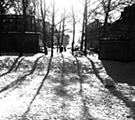Bachelor / Interior Architecture and Furniture Design
Cecilia Cronelid

Emma Pålsson
Ida Ahlgren

Johan Andrén

Jonathan Wahlstedt
Linnea Nordin

Maria Mattsson
Mattias Sellden
Sara Persson
Sara Strömbäck
Tamar Salamon
Veine Bartos

Yonna Levy Nilsson
As an interior architect and furniture designer, you are almost always creating something to be built and that other people will use.
People – others and yourself – will benefit from what you design.
Here on the program of Interior Architecture and Furniture Design, the education is characterized by all the students having ample opportunities to develop knowledge through a variety of processes. Many apply to IA at Konstfack in order to have the opportunity to build and create using authentic materials. The education rests on an artistic foundation.
The Bachelor’s Degree demonstrates the fundamental knowledge covered by our training. But various human starting points nevertheless result in completely different projects. This year’s degree projects encompass wild ideas and unconventional questions, peaceful protests and constructive social criticism.
The degree projects usually formulate questions that can be developed further for the rest of your life… at Master’s level and in the profession of interior architect and furniture designer:
How should women get to pee and how can the design of the place they pee contribute to a more equal society?
How should our children have the opportunity to build and play and be able to rely on their competence?
What significance does sound have in our built environment?
People – others and yourself – will benefit from what you design.
Here on the program of Interior Architecture and Furniture Design, the education is characterized by all the students having ample opportunities to develop knowledge through a variety of processes. Many apply to IA at Konstfack in order to have the opportunity to build and create using authentic materials. The education rests on an artistic foundation.
The Bachelor’s Degree demonstrates the fundamental knowledge covered by our training. But various human starting points nevertheless result in completely different projects. This year’s degree projects encompass wild ideas and unconventional questions, peaceful protests and constructive social criticism.
The degree projects usually formulate questions that can be developed further for the rest of your life… at Master’s level and in the profession of interior architect and furniture designer:
How should women get to pee and how can the design of the place they pee contribute to a more equal society?
How should our children have the opportunity to build and play and be able to rely on their competence?
What significance does sound have in our built environment?
Unique design meets mass production – what happens? What makes a piece of furniture unique?
If, for example, you utilize wood’s intrinsic properties like shipbuilders formerly did, how can this be exploited in the design of furniture?
A piece of furniture where the surface’s unique pattern prevails over form…
Furniture where memories and home are the focus…
A piece of furniture where sketches and notes are integrated into the surface using modern technology…
Furniture where function comes to a head…
And the kitchen couch, how could it be designed today?
How do you create rooms?
Can a room come into being thanks to a vision from a story in a book?
What significance does a blueprint have when creating rooms and how could the blueprint say more than a thousand words?
What will we use all the in-between spaces in the city for? Is there anyone who sees them?
And last but not least, imaginary rooms…
Karin Sjökvist Tyrefors, Senior Lecturer of Interior Architecture & Furniture Design
If, for example, you utilize wood’s intrinsic properties like shipbuilders formerly did, how can this be exploited in the design of furniture?
A piece of furniture where the surface’s unique pattern prevails over form…
Furniture where memories and home are the focus…
A piece of furniture where sketches and notes are integrated into the surface using modern technology…
Furniture where function comes to a head…
And the kitchen couch, how could it be designed today?
How do you create rooms?
Can a room come into being thanks to a vision from a story in a book?
What significance does a blueprint have when creating rooms and how could the blueprint say more than a thousand words?
What will we use all the in-between spaces in the city for? Is there anyone who sees them?
And last but not least, imaginary rooms…
Karin Sjökvist Tyrefors, Senior Lecturer of Interior Architecture & Furniture Design
Som inredningsarkitekt och möbelformgivare skapar du nästan alltid något som ska byggas och som andra människor ska använda.
Människor – andra och du själv – har nytta av det du formger.
På Inredningsarkitektur och Möbeldesign kännetecknas utbildningen av att alla studenter har stora möjligheter att utveckla kunskap genom en rad olika processer. Många söker till oss för att få möjlighet att bygga och skapa i autentiska material.
Kandidatexamen visar på de grundläggande kunskaper som utbildningen omfattar. Men olika mänskliga utgångspunkter resulterar trots detta i helt väsensskilda projekt. Årets kandidatexamensprojekt rymmer vilda idéer och egensinniga frågeställningar, stillsamma protester och konstruktiv samhällskritik.
I kandidatexamensprojektet formuleras oftast frågor som kan komma att utvecklas vidare resten av livet… såväl på masternivå som i yrket som inredningsarkitekt och möbelformgivare:
Hur ska kvinnor få kissa och hur kan kissplatsens utformning bidra till ett jämlikare samhälle?
Hur ska våra barn få möjlighet att bygga och leka och kunna lita på sin kompetens?
Vad har ljudet för betydelse i vår byggda miljö?
Människor – andra och du själv – har nytta av det du formger.
På Inredningsarkitektur och Möbeldesign kännetecknas utbildningen av att alla studenter har stora möjligheter att utveckla kunskap genom en rad olika processer. Många söker till oss för att få möjlighet att bygga och skapa i autentiska material.
Kandidatexamen visar på de grundläggande kunskaper som utbildningen omfattar. Men olika mänskliga utgångspunkter resulterar trots detta i helt väsensskilda projekt. Årets kandidatexamensprojekt rymmer vilda idéer och egensinniga frågeställningar, stillsamma protester och konstruktiv samhällskritik.
I kandidatexamensprojektet formuleras oftast frågor som kan komma att utvecklas vidare resten av livet… såväl på masternivå som i yrket som inredningsarkitekt och möbelformgivare:
Hur ska kvinnor få kissa och hur kan kissplatsens utformning bidra till ett jämlikare samhälle?
Hur ska våra barn få möjlighet att bygga och leka och kunna lita på sin kompetens?
Vad har ljudet för betydelse i vår byggda miljö?
Den unika utformningen möter serieproduktion, vad händer? Vad gör en möbel unik?
Om man t ex utnyttjar träets inneboende egenskaper likt skeppsbyggare har gjort tidigare, hur kan det utnyttjas i formgivningen av möbler?
En möbel där ytans unika mönster får råda över formen…
Möbler där minnen och hem står i fokus…
En möbel där skisser och anteckningar integreras i ytan med modern teknik…
Möbler där funktionen ställs på sin spets…
Och kökssoffan; hur skulle den kunna utformas idag?
Hur skapar man rum?
Kan ett rum bli till tack vare en vision från en berättelse i en bok?
Vad har ritningen för betydelse när man skapar rum och hur skulle ritningen kunna säga mer än tusen ord?
Vad ska vi ha alla mellanrum i staden till? Är det någon som ser dem?
Och sist men inte minst, de imaginära rummen…
Karin Sjökvist Tyrefors, lektor i Inredningsarkitektur & Möbeldesign
Om man t ex utnyttjar träets inneboende egenskaper likt skeppsbyggare har gjort tidigare, hur kan det utnyttjas i formgivningen av möbler?
En möbel där ytans unika mönster får råda över formen…
Möbler där minnen och hem står i fokus…
En möbel där skisser och anteckningar integreras i ytan med modern teknik…
Möbler där funktionen ställs på sin spets…
Och kökssoffan; hur skulle den kunna utformas idag?
Hur skapar man rum?
Kan ett rum bli till tack vare en vision från en berättelse i en bok?
Vad har ritningen för betydelse när man skapar rum och hur skulle ritningen kunna säga mer än tusen ord?
Vad ska vi ha alla mellanrum i staden till? Är det någon som ser dem?
Och sist men inte minst, de imaginära rummen…
Karin Sjökvist Tyrefors, lektor i Inredningsarkitektur & Möbeldesign
